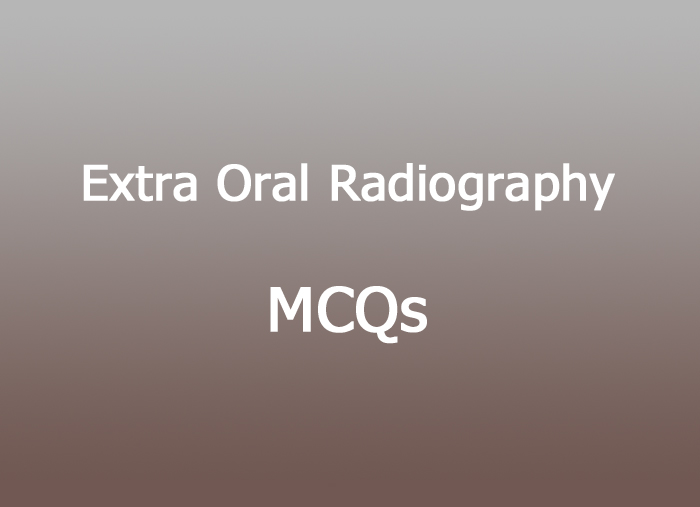- NEED HELP? CALL US NOW
- +919995411505
- [email protected]

1. In cephalo metric radiography the distance between the subject and the source of X ray is
A. 2 feet
B. 48 inches
C. 4.8 metres
D. 5 feet
Answer:D
2. Ankylosis of TMG can be best viewed in
A. Lateral oblique views
B. PA view
C. Transcranial
D. Lateral view
Answer:C
transcranial view
• The cassette is placed flat against the patient’sear and centered over the TM- joint of interest,against the facial skin parallel to the sagittalplane.
• The patients head is adjusted so that thesagittal plane is vertical.
• The ala-tragus line is parallel to the floor.
• This view is taken with both open and closed position.
3.submentovertex is useful in viewing
A. Body of mandible
B. Fracture of zygomatic arch
C. Fracture of base of skull
D. All of the above
Answer : D
SUBMENTOVERTEX (BASE OF THE SKULL)
• The image receptor is positioned parallel to patient’stransverse plane and perpendicular to the midsagittal and coronal planes. To achieve this, the patients neck is extended as far backward as possible,with the canthomeatal line forming a 10 degree angle with the receptor.
• The central beam is perpendicular to the image eceptor, directed from below the mandible toward the vertex of the skull , and centered about 2cms anterior to a line connecting the right and left condyles.
• assessing potential pathology from trauma or disease progression to the basal skull structures, including the foramen ovale, foramen spinosum and sphenoid sinuses.
4.the best radiographic view for TMG is
A. Lateral oblique views
B. PA view
C. Water’s view
D. OPG
Answer : D
The orthopantomogram (also known as an orthopantomograph, pantomogram, OPG or OPT) is a panoramic single image radiograph of the mandible, maxilla and teeth. It is often encountered in dental practice and occasionally in the emergency department; providing a convenient, inexpensive and rapid way to evaluate the gross anatomy of the jaws and related pathology.
5.zygoma fractures can be best viewed by
A. Occipitomental view
B. Lateral oblique views
C. Lateral skull view
D. Towne’s view
Answer :A
The occipitomental (OM) or Waters view is an angled PA radiograph of the skull, with the patient gazing slightly upwards.
6.Ghost like shadow seen in
A. MRI
B. OPG
C. CT
D. Cephalogram
Answer:B
A ghost image is a commonly observed artifact in an orthopantomogram whereby a dense, often metallic object is located between the source of x-ray and the focal center, resulting in a duplicate ‘ghost’ image at the contralateral aspect of the image.
7.Water’s projection is useful for evaluating
A. Frontal and ethmoid sinuses
B. Zygomaticofrontal suture and nasal cavity
C. Maxillary sinuses
D. All of the above
Answer:D
8.which of the following is used to show the base of the skull,sphenoid sinuses,position and orientation of the condyles,and fractures of the zygomatic arch
A. The TMG surgery
B. Submentovertex projection
C. Reverse-towne projection
D. The facial profile survey
Answer:B
9. least radiation exposure occurse in
A. MRI
B. CT
C. Arthography
D. OPG
Answer:A
10.radiographic projection used to diagnose horizontal favourable and unfavourable fracture of mandible is
A. Lateral oblique view of mandible
B. PA view of skull
C. Reverse-towne projection
D. Water’s view
Answer:A




